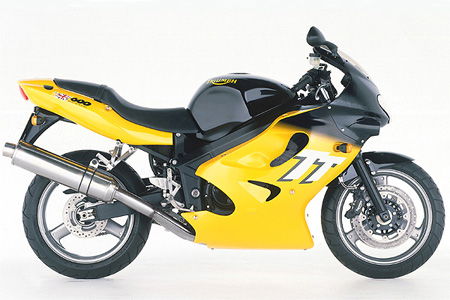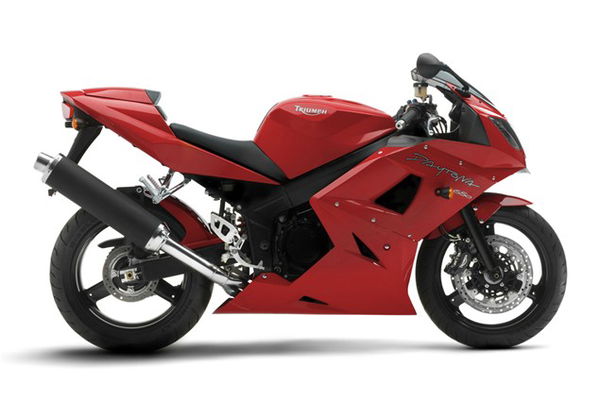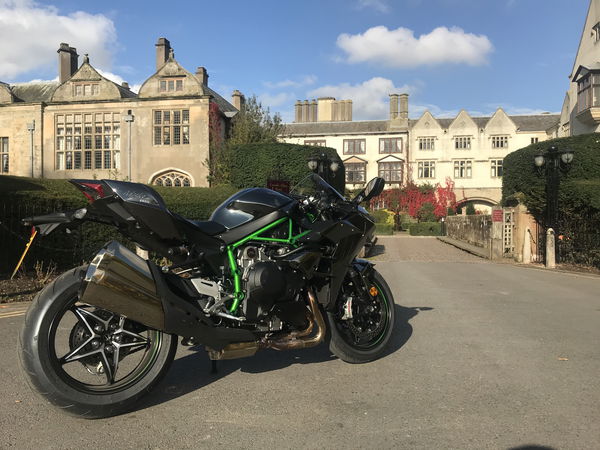Used Review: Triumph TT600-Daytona 600-650
Yep, it's true. Back in 1996, when Triumph first mooted a middleweight sportsbike - codenamed T806 - they looked at making a triple.

 |
But, after listening to a number of 'focus groups' in the USA and the UK, it was felt that a tried-and-trusted four-cylinder layout should be used. From this we can gather that listening to focus groups can be a bad idea, for 10 years down the line we're full circle with the new Daytona 675 triple...
So, in 1999 we got a four-cylinder motorcycle that scarcely deviated from the standard fare of Japanese middleweight sports bikes, apart from the addition of fuel injection. Triumph managed to squeeze 110bhp out of the motor, but in its earliest form it lacked mid-range thrust and was justly criticised for this. The styling was also on the conservative side, with one of the colour schemes - yellow and black - being almost identical to that of the new ally-framed Honda CBR600F launched at the same time.
But then things improved. The TT600's chassis and brakes attracted deserving praise (some hailed it as 'the best-handling 600cc production bike ever') and fixes for the fuel mapping added mid-range push.
What was needed was a new, less bland look, and this came with the much nicer Daytona 600. In came angular looks and a distinctive style, all wrapped around the still-sharp chassis and a motor with more mid-range. It was at last in the same ballpark as the Japanese opposition, with - again - only a slightly hesitant mid-range letting it down. Finally
Triumph followed Kawasaki's lead and increased the engine's displacement.
Now the 675 is here, dealers will want to shift unsold stock - and others will come in as part-exes against the new triple. Time for a bargain hunt...
HOT STALLING
Many reported cases of this. You'll be tootling along and one of the following things will happen: if you're at the traffic lights, the thing will conk out, or - if you're riding with a closed throttle - cut out as you're moving. Owners say there are a number of reasons for and ways around it. Some say the problem will abate as you run the bike in, others say you need to get the bike to a dealer to mate the 'tune' of the bike to the end-can or Power Commander you're running. Others say it's the oxygen sensor or imbalanced throttle bodies. Correcting all of the above seems to work for the owners, followed by a tightening of the throttle cable for luck.
ENGINE
Early TT600s felt two-stroke peaky, but got better with age. Even so, circa 2001 TT600s would only start to pull strongly from around 8000 revs. The Daytona 600 is much improved, pulling from around 7000rpm, but the real oomph comes in at around 9000. Best of the bunch is the Daytona 650. Instead of waiting for 7000rpm to appear on the tacho, you feel proper drive from as low as 5000rpm.
ENGINE PROBLEMS
The TT and Daytona seem to have a fair few oil leak issues - although, to be fair, we've also been contacted by a number of owners who've seen 30,000 miles and over with no problems whatsoever. Areas to watch for include: gearshift shaft/lever, clutch cable connection, breather pipe (the gasket in the crankcase breather can wear out, apparently), crankshaft oil seal and the filler cap/dipstick. Some only seem to leak when they're hot, but one owner even reported that he'd had the problem 'fixed' six times with five new seals, while another was adding a quart of oil every two weeks. Do check with the seller if they've suffered any of these problems and ask what work the dealers have actually carried out on the bike. If you can, take the fairing off and have a good look.
STARTING
Quite a few owners report difficulties, often due to the engine being hot (switch it off straight away and then re-try) or a loose kill-switch connection.
COMFORT
Excellent. It's easily the most comfy sports 600 out there, capable of transporting most shapes and sizes (even six-foot plus) without inducing premature curvature of the spine.
AFTERMARKET PARTS
As we've mentioned before with the Sprint RS and 955i, a stack of Triumph official parts does the value no harm at all. However, some owners reckon the quality can be variable. So check what's on the bike when you buy. Aftermarket bits made by other manufacturers are harder to find, due to the smaller volumes sold by Triumph. A word about aftermarket end-cans: a few owners have had have issues with sleeves not fitting properly and gas escaping from the edges. Check this before you buy.
RECALLS
May 2000 TT600: Recall for sidestand assembly bolt replacement
June 2000 TT600: Sprag housing bolts may come loose and damage alternator brushes and stop engine
November 2001 TT600 (and others): Clutch cable may fray and snap
July 2004 TT600/Daytona 600 (and others): Possible fracture of male connectors on fuel hoses
ENGINE MANAGEMENT LIGHT STUCK ON
Both the TT600 and the Daytona can suffer from this old Triumph foible. If the bike's been stood for some time, then you have to get the bike through three heat cycles. Fire it up and run the bike until the fan cuts in. Switch off and repeat a further three times. The light should now go out. If the light is still on, contact a dealer.
COOLANT LEAKS
Coolant leaks have been reported. Loose hose clips are the main culprit. Check the inlet and outlet hoses to and from the radiator - blue-ish green flecks are a tell-tale sign of escaping liquid.
FINISH
Not the best by a long chalk. You need to clean the bike until your hands bleed to keep the thing looking nice. Treat it to merely average care and the Triumph will start to show its age twice as fast as Japanese machines. Disc bolts will go rusty, shock bodies will tarnish and the engine casing will also look scrappy
if you don't clean the bike after a winter ride. Be unstinting in your application of fettling products.
DEALERS
Triumph's dealership network offers excellent back-up, according to the majority of our readers. Many lay on demo bikes while yours are in for service. Daytona 650 owner Paul Sayer said: "It was so different to the Ducati dealer I'd used before when I had a Monster. With Triumph it was 'When do you want to test ride the 650? Oh, and we've prepped the Daytona 955i while you were on the 650, try it - we insist - you may prefer it.' Servicing was also while-you-wait, or I had a courtesy bike if longer. Brilliant."
BRAKES
Excellent when new on all models, but some owners have suffered the same sponginess as our own longterm Speed Triple and Daytona 650. The problem comes and goes on some bikes and stays put on others. Bleeding may alleviate the sponginess temporarily, completely or not at all. Triumph has yet to recognise a particular problem. Our Speed Triple's brakes were sorted with new, properly lubricated caliper piston seals. Other bikes have been sorted with an aftermarket master cylinder.

Yep, it's true. Back in 1996, when Triumph first mooted a middleweight sportsbike - codenamed T806 - they looked at making a triple.
But, after listening to a number of 'focus groups' in the USA and the UK, it was felt that a tried-and-trusted four-cylinder layout should be used. From this we can gather that listening to focus groups can be a bad idea, for 10 years down the line we're full circle with the new Daytona 675 triple...
So, in 1999 we got a four-cylinder motorcycle that scarcely deviated from the standard fare of Japanese middleweight sports bikes, apart from the addition of fuel injection. Triumph managed to squeeze 110bhp out of the motor, but in its earliest form it lacked mid-range thrust and was justly criticised for this. The styling was also on the conservative side, with one of the colour schemes - yellow and black - being almost identical to that of the new ally-framed Honda CBR600F launched at the same time.
But then things improved. The TT600's chassis and brakes attracted deserving praise (some hailed it as 'the best-handling 600cc production bike ever') and fixes for the fuel mapping added mid-range push.
What was needed was a new, less bland look, and this came with the much nicer Daytona 600. In came angular looks and a distinctive style, all wrapped around the still-sharp chassis and a motor with more
mid-range. It was at last in the same ballpark as the Japanese opposition, with - again - only a slightly hesitant mid-range letting it down. Finally Triumph followed Kawasaki's lead and increased the engine's displacement.
Now the 675 is here, dealers will want to shift unsold stock - and others will come in as part-exes against the new triple. Time for a bargain hunt...











